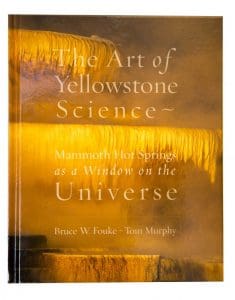
As an early explorer to the area put it, “No human architect ever designed such intricate fountains as these. The water trickles over the edges from one to another, blending them together with the effect of a frozen waterfall.”
Mammoth is in a constant state of change. If you look with a careful eye, you will notice that certain springs and formations have transformed in some way, or have disappeared altogether. Incredibly, a ton (yes, a ton) of new travertine is deposited across the complex every single day!

Because of the dynamic forces and natural beauty ever-present in Mammoth, it is the perfect window into the universe. Water rising from below the Earth’s surface, combined with heat-loving organisms called thermophiles, create the dramatic color and formations found at Mammoth and throughout Yellowstone. These microscopic organisms and volatile conditions are thought to be similar to those present at the beginning of life on Earth. As stated in the book, “Microbial life is the oldest, largest reservoir of genetic diversity on our planet, dwarfing the biodiversity of all the plants and animals we can see with the naked eye that dwell in rain forests, coral reefs, and the world’s oceans.”
In fact, scientists have found that the microbes thriving in Mammoth have unique properties and processes with very real applications in human medicine, energy generation, environmental sustainability, and even the search for life throughout the cosmos. The excitement and potential implications of this work have led to a significant increase in the exploration and scientific study of this seemingly alien life on earth.
Fouke’s scientific focus and infectious enthusiasm, combined with Murphy’s stunning photographs, combine to create a new approach to connecting with the world around us. The aesthetic beauty and vast diversity on the planet draw you in and spark a curiosity to learn more, similar to that contemplative “sense of wonder” we feel in the face of awe-inspiring beauty.

Whether you are a serious scientist or artist, or you just love Yellowstone, The Art of Yellowstone Science will leave you with a deeper understanding of the park, and perhaps leave you inspired to come back primed with a fresh perspective.
You can purchase The Art of Yellowstone Science at any of our Yellowstone Park Store locations or online at https://shop.yellowstone.org/yellowstone-the-art-of-science.
All images by Tom Murphy

Comments are closed.